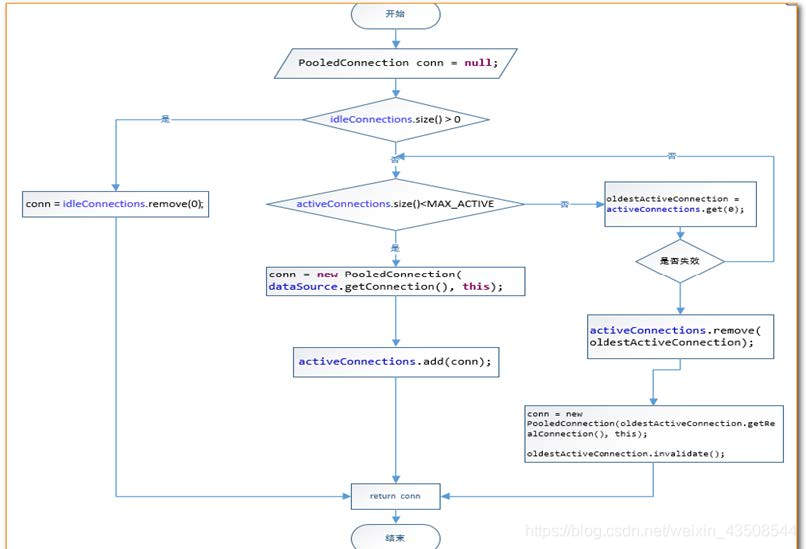一、MyBatis连接池与事务的深入
1.1 MyBatis的连接池技术
1.1.1 连接池的分类
UNPOOLED:不适用连接池的数据源POOLED:使用连接池的数据源JNDI:使用JNDI实现的数据源
- MyBatis内部分别定义了实现
java.sql.DataSource接口的UnPooledDataSource和PooledDataSource,来表示UNPOOLED、POOLED类型的数据源。 - 一般采用
POOLED数据源
1.1.2 数据源的配置
在
SqlMapConfig.xml文件中配置数据源<dataSource type="POOLED"> <property name="driver" value="${jdbc.driver}"/> <property name="url" value="${jdbc.url}"/> <property name="username" value="${jdbc.username}"/> <property name="password" value="${jdbc.password}"/> </dataSource>
1.1.3 MyBatis中DataSource的存取
- MyBatis是通过工厂模式来创建数据源DataSource对象的,
org.apache.ibatis.datasource.DataSourceFactory,通过其getDataSource()方法返回数据源DataSource。
1.1.4 MyBatis中连接的获取过程分析
先找空闲池中有没有空闲的连接
- 有。直接返回
无。看活动池是否已经达到最大数量
- 否。在活动池创建一个新的连接来用
- 是。等待最老的那个连接被归还后,重置后返回


1.2 MyBatis的事务控制
MyBatis框架是对JDBC的封装,所以其本身也是用JDBC的
setAutoCommit()方式来设置事务的提交方式。session = sessionFactory.openSession(true);//设置自动提交
二、MyBatis的动态sql语句
2.1 if标签
2.1.1 持久层DAO接口
/**
* 根据条件查用户
* @param user
* @return
*/
List<User> findUserByCondition(User user);2.1.2 持久层DAO映射配置
where 1=1的作用- 为了加
and拼接 sql 语句。因为不能保证拼接的sql语句是否带and,索性加一个永真条件,是的后面添加的条件,都带有and,那就不用判断了。
- 为了加
- 不是sql语句中的内容,严格区分大小写
test:判断条件字段是否为空
<select id="findUserByCondition" resultMap="userMap" parameterType="user">
select * from user where 1=1
<if test="username != null">
and username = #{username}
</if>
<if test="sex != null">
and sex = #{sex}
</if>
</select>2.2 where标签
- 简化
where 1=1的拼装,可以使用where标签
2.2.1 持久层DAO接口
/**
* 根据条件查用户
* @param user
* @return
*/
List<User> findUserByCondition(User user);2.2.2 持久层DAO映射配置
<select id="findUserByCondition" resultMap="userMap" parameterType="user">
select * from user
<where>
<if test="username != null">
and username = #{username}
</if>
<if test="sex != null">
and sex = #{sex}
</if>
</where>
</select>2.3 foreach标签
进行范围查询时,对参数进行传递。如:
SELECT * FROM USERS WHERE username LIKE '%张%' AND (id =10 OR id =89 OR id=16)
2.3.1 条件实体类QueryVo
- 在条件实体类
QueryVo中加入List集合用于封装参数
package com.ruki.domain;
import java.util.List;
public class QueryVo {
private User user;
private List<Integer> ids;
public List<Integer> getIds() {
return ids;
}
public void setIds(List<Integer> ids) {
this.ids = ids;
}
public User getUser() {
return user;
}
public void setUser(User user) {
this.user = user;
}
}
2.3.2 持久层DAO接口
/**
* 子查询foreach标签
* @param vo
* @return
*/
List<User> findUserInIds(QueryVo vo);2.3.3 持久层DAO映射配置
collection:集合属性名open:开始close:结束item:遍历出来的元素separator:分隔符#{id}:将值取出,与item的值对应
<!-- foreach标签 -->
<select id="findUserInIds" resultMap="userMap" parameterType="queryvo">
select * from user
<where>
<if test="ids != null and ids.size()>0">
<foreach collection="ids" open="and id in (" close=")" item="id" separator=",">
#{id}
</foreach>
</if>
</where>
</select>2.4 简化编写的sql片段
- 在持久层DAO映射配置中,有许多重复的查询语句
select * from user,可将其提取出来。 sql:id:提取出来的sql片段名
include:refid:引用sql片段的id
<!-- sql的抽取 -->
<sql id="defaultUser">
select * from user
</sql>
<!-- 查询所有用户 -->
<select id="findAll" resultMap="userMap">
<include refid="defaultUser"></include>
<!-- select * from user -->
</select>三、MyBatis多表查询(一对一)
3.1 方式一:新建全属性实体类
- 定义专门的pojo类作为输出类型,定义sql查询结果集所有的字段,并将字段封装到含有两部分属性的
AccountUser实体类中,然后进行输出。
3.1.1 实体类
Account实体类
public class Account implements Serializable {
private Integer id;
private Integer uid;
private Double money;
//getter setter toString ...
}User实体类
public class User implements Serializable {
private Integer id;
private String username;
private String address;
private String sex;
private Date birthday;
//getter setter toString ...
}3.1.2 sql语句_等值连接(关键)
SELECT
account.*,
user.username,
user.address
FROM
account,
user
WHERE account.uid = user.id3.1.3 AccountUser类(含全属性)
- 继承
Account类,并且包含账户信息的同时,还要包含用户信息
public class AccountUser extends Account {
private String username;
private String address;
//getter setter toString ...
}3.1.4 IAccountDao接口
/**
* 查询所有账户,以及对应的用户信息
* @return
*/
List<AccountUser> findAllAccountUser();3.1.5 IAccountDao.xml
<!-- 查询所有AccountUser -->
<select id="findAllAccountUser" resultType="accountuser">
select a.*, u.username, u.address from account a, user u where a.uid = u.id;
</select>3.1.6 测试
@Test
public void testFindAllAccountUser(){
List<AccountUser> aus = accountDao.findAllAccountUser();
for(AccountUser au : aus){
System.out.println(au);
}
}3.2 方式二:添加从属关系属性
- 使用
resultMap,定义专门的resultMap用于映射一对一查询结果。 - 通过面向对象的(has a)关系可以得知,我们可以在
Account类中加入一个User类的对象来代表这个账户是哪个用户的
3.2.1 修改Account类
public class Account implements Serializable {
private Integer id;
private Integer uid;
private Double money;
//从表应包含主表的引用属性
private User user;
//getter setter toString
}3.2.2 修改Account接口方法
/**
* 查询所有账户
* @return
*/
List<Account> findAll();3.2.3 重新定义AccountDao.xml
一对一关系映射采用
association标签associationproperty:属性名column:外键字段名javaType:包装类型。(一般为全限定类名,但这里已经在SqlMapConfig.xml文件中设置了别名)
<!-- 定义封装account和user的resultMap -->
<resultMap id="accountUserMap" type="account">
<id property="id" column="aid"></id>
<result property="uid" column="uid"></result>
<result property="money" column="money"></result>
<!-- 一对一关系的映射:配置封装user的内容 -->
<association property="user" column="uid" javaType="user">
<id property="id" column="id"></id>
<result property="username" column="username"></result>
<result property="address" column="address"></result>
<result property="sex" column="sex"></result>
<result property="birthday" column="birthday"></result>
</association>
</resultMap>
<!-- 查询所有用户 -->
<select id="findAll" resultMap="accountUserMap">
select u.*, a.id aid, a.uid, a.money from account a, user u where u.id = a.uid
</select>3.2.4 测试
/**
* 测试查询所有账户
*/
@Test
public void testFindAll() throws IOException {
List<Account> accounts = accountDao.findAll();
for(Account account : accounts){
System.out.println("---每一个account的信息");
System.out.println(account);
System.out.println(account.getUser());
}
}四、MyBatis多表查询(一对多)
4.1 编写SQL语句(左外连接)
select
u.*,
a.id,
a.uid,
a.money
from
user u
LEFT JOIN account a ON a.UID = u.id;4.2 User类中添加List<account>
public class User implements Serializable {
private Integer id;
private String username;
private String address;
private String sex;
private Date birthday;
//主表包含从表的属性
private List<Account> accounts;
//getter setter toString
}4.3 IUserDao接口
/**
* 查找所有
* @return
*/
List<User> findAll();4.4 IUserDao.xml
一对多采用
collection标签collectionproperty:属性名ofType:泛型(一般为全限定类名,但这里已经在SqlMapConfig.xml文件中设置了别名)
<resultMap id="userAccountMap" type="user">
<id property="id" column="id"></id>
<result property="username" column="username"></result>
<result property="address" column="address"></result>
<result property="sex" column="sex"></result>
<result property="birthday" column="birthday"></result>
<!-- collection是用于建立一对多中集合属性的对应关系
ofType用于指定集合元素的数据类型 -->
<collection property="accounts" ofType="account">
<id property="id" column="aid"></id>
<result property="uid" column="uid"></result>
<result property="money" column="money"></result>
</collection>
</resultMap>
<!-- 查询所有用户 -->
<select id="findAll" resultMap="userAccountMap">
select * from user u LEFT JOIN account a ON a.UID = u.id;
</select>4.5 测试
@Test
public void testFindAll() throws IOException {
List<User> users = userDao.findAll();
for(User user : users){
System.out.println(user);
System.out.println(user.getAccounts());
}
}五、MyBatis多表查询(多对多)
- 通过中间表形成多对多关联
5.1 Role -> User 的多对多
5.1.1 编写sql语句(role为驱动表)
select
u.*,
r.ID as rid,
r.ROLE_NAME,
r.ROLE_DESC
from
role r
left join
user_role ur on r.ID = ur.RID
left join
user u on ur.UID = u.id;5.1.2 Role实体类
public class Role implements Serializable {
private Integer roleId;
private String roleName;
private String roleDesc;
//多对多的关系映射:一个角色可以赋予多个用户
private List<User> users;
//getter setter toString
}5.1.3 IRoleDao接口
/**
* 查询所有role
* @return
*/
List<Role> findAll();5.1.4 IRoleDao.xml
<?xml version="1.0" encoding="UTF-8"?>
<!DOCTYPE mapper
PUBLIC "-//mybatis.org//DTD Mapper 3.0//EN"
"http://mybatis.org/dtd/mybatis-3-mapper.dtd">
<mapper namespace="com.ruki.dao.IRoleDao">
<resultMap id="roleMap" type="role">
<id property="roleId" column="rid"></id>
<result property="roleName" column="role_name"></result>
<result property="roleDesc" column="role_desc"></result>
<collection property="users" ofType="user">
<id property="id" column="id"></id>
<result property="username" column="username"></result>
<result property="address" column="address"></result>
<result property="sex" column="sex"></result>
<result property="birthday" column="birthday"></result>
</collection>
</resultMap>
<select id="findAll" resultMap="roleMap">
select u.*, r.ID as rid, r.ROLE_NAME, r.ROLE_DESC from role r
left join user_role ur
on r.ID = ur.RID
left join user u
on ur.UID = u.id;
</select>
</mapper>5.1.5 测试
@Test
public void testFindAll() throws IOException {
List<Role> roles = roleDao.findAll();
for(Role role : roles){
System.out.println("------------------------");
System.out.println(role);
System.out.println(role.getUsers());
}
}5.2 User -> Role 的多对多
- 原理同上,sql顺序改变一下,
User类中添加roles属性